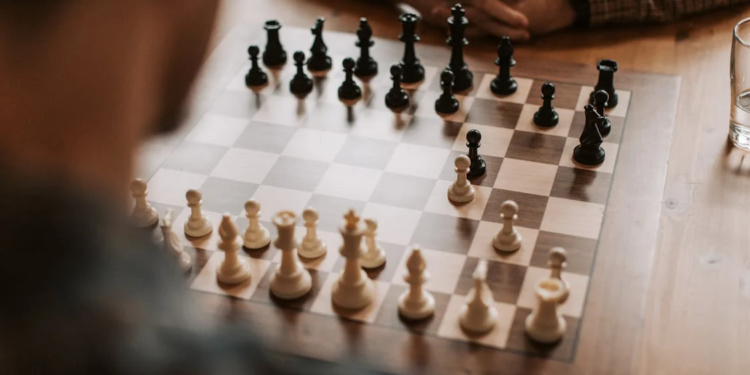“Chess is the gymnasium of the mind.” – Blaise Pascal.
Chess is a game that has been treasured for unending years, bringing mental stimulation and challenge to all and sundry. It does not matter whether you are a novice desperate to grasp the rudiments of the game or a casual player who wants to hone their setup skills, knowing how to properly position a chess table is one of the initial and important steps in winning the game. A chessboard that is well arranged helps in laying a thinking strategy and also gives both players a clear and neat starting position.
This blog is mainly focused on how to carry out proper chess table setup, why it is important to do proper positioning, and some fun facts to help you appreciate the game even more.
The Basics of Chess Table Setup
You might be surprised to learn that there is very little to set up a chess table, but certainly, the finer details have to be observed so that the game is fair and enjoyable. A standard chessboard should be an eight-by-eight grid, which equals sixty-four boxes, where light (white) and dark (black) boxes alternate. This is how to go about if you want to arrange the chess table the right way:
1. The Position of the Chessboard
The first rule that should be followed for chess table setup is how the chessboard should be arranged. The last row of the chessboard on the player’s right-hand side should have a white (light) square. This is an important aspect often neglected by novices. If the board is twisted around, well, all the game arrangement goes to the dogs.
2. Place the Rooks in the Corners
The pieces are set up symmetrically, with each player having 16 pieces. Start by placing the rooks (also called castles) in the four corners of the board—one on the far left and one on the far right for each player. Rooks are strong pieces as they can move any number of squares along a straight line, either horizontal or vertical, so where they are placed within the game is important for defence and strategy later on in the game.
3. Place the Knights Next to the Rooks
The next pieces to be positioned are the knights (represented by horseheads). Place them immediately next to the rooks. Knights are unique in the sense that they move in an ‘L’ shape- two squares in one direction and then a square in a perpendicular direction. They can jump over other pieces and this makes them very unpredictable but also very useful in some situations.
4. Place the Bishops Next to the Knights
Position the bishops next to the knights. Bishops move diagonally on the board and every player has two bishops, one of which will play on the light squares only and the other on the dark squares only. This pair of bishops provides a lot of latitude while controlling the board.
5. Mold the Queens
This is to be expected given that chess has a queen, which is the most powerful of all the chess pieces. The Queen is capable of moving any distance in a straight line, be it horizontally, vertically or diagonally. It is important to note the following rule while placing the queens on the board: a queen always draws her first position of the game on a square of her colour. This indicates that the queen who plays with the white pieces occupies a light (or white) square, while the queen who plays with the black pieces occupies a dark (or black) square at the centre of the board.
6. Place the Kings
The king is placed in the empty centre square which is beside the queen. The king is regarded as the most vital piece in chess because there is no way to win without putting the opponent’s king in check. On the contrary, the king is one of the pieces that can easily be contained within the player’s board moving just one square at any given time.
7. Set Up the Pawns
Males often place that row of pawns in the parking zone closest to other pieces in the known orientation. Despite being the most abundant, and shielding any aggression to the corners, pawns are the least valued pieces, only able to move one space ahead (apart on the first turn which grants them an option of moving two) and attack only on the sides. Their meagre powers notwithstanding, pawns are extremely essential when it comes to control of the board and the eventual execution of one’s plan.
8. White Always Moves First
A game of chess starts after arranging the pieces on the chess board with the white pieces making the first move. This custom has existed for gambling practice for more than a hundred years and it is one of the laws of chess that is observed everywhere.
The Importance of Proper Chess Table Setup
You might wonder why it’s so important to arrange the chessboard correctly. A proper setup ensures that both players begin the game on an equal footing, following international standards. The symmetry of the pieces—rooks in the corners, knights next to them, bishops flanking the king and queen—ensures that both players have equal opportunities for strategic gameplay.
Additionally, when you’re playing in tournaments or official settings, any misplacement of pieces can lead to disqualification or at the very least, confusion that could affect the outcome of the game. Correct setup fosters clarity and fairness, allowing players to focus on strategy rather than logistics.
Fun Facts About Chess Setup
- History of the Queen’s Placement: The principle stating that the queen should be placed on the same coloured square as her dress (white for white and black for black) was fixed in the 15th century. It’s approximately the same period when the queen acquired her new sweeping range of movement. Prior to this, it was a much weaker piece, moving only one square diagonally unlike in all directions as it is today.
- Chess Set-up Orientation Norms: The assumption that a square in the right corner should be white (light) is said to have come during medieval times and chess became very popular in Europe. This particular convention provides a similar play aversion to time differences as players all over the world always know how the game is set up.
- The Primary Chess Board: The Lewis chessmen are among the most well-known chess sets which consist of 12th-century figures that were found in a stone castle in Scotland. These provided figures are made out of carved and engraved walrus tusks and pieces give an idea of how the game has developed with time.
- Different Chess Set Compositions: Although most of the contemporary chess sets are designed using wood or plastic, some deluxe chess sets were designed using expensive materials such as jade, ivory, or even gold. The most expensive chess set in the world, the Pearl Royale Chess Set is worth more than 4 million dollars and is designed using platinum, diamonds, and pearls.
Everything flows, and it motivated a writer to say: Chess is not a game of moving pieces; it is an exercise – a thought exercise. They add that with the proper installation of the chess table, a good strategy, focus, and eventually success in the game will be achievable. Imagine the fun!











































































